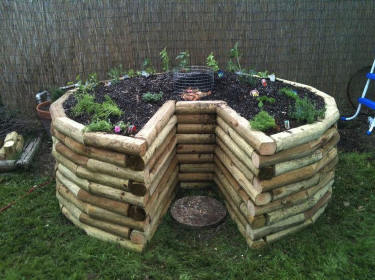(7/3) A new method of gardening is proving to be less labor-intensive and more affordable for all individuals who desire to grow their own food. A keyhole garden introduces a no-till, permaculture design in the form of a raised bed with a compost basket at the top to provide nourishment for your garden. These beautiful gardens are ideal for small spaces and can
accommodate a variety of vegetables, herbs and flowers and can be easily adapted to fit the individual needs of the gardener.
First introduced in arid African regions, keyhole gardening began as a grass roots movement to help poor families develop the skills they needed to grow crops on infertile land. The concept has proven to be so successful that it is now being practiced in the United States.
Keyhole gardens are circular raised-bed gardens. The larger outer circle is where the crops are planted. The center portion of these gardens is an active composting basket. A small aisle is built to access the compost basket. Keyhole gardens get their name from the bird’s eye view of these features.
 Keyhole gardens are currently making their way into backyards everywhere. The composting basket is essential for the success of keyhole gardens. Composting utilizes the natural processes of decay to convert organic materials such as leaves, grass and food scraps into a valuable humus-like material called
compost. The compost basket allows the gardener to better maintain ideal levels of air, moisture, food, and temperature so that decomposition proceeds much faster than normal. With a properly managed compost basket you can turn your leaves, grass and food scraps into excellent compost in just a few months.
Keyhole gardens are currently making their way into backyards everywhere. The composting basket is essential for the success of keyhole gardens. Composting utilizes the natural processes of decay to convert organic materials such as leaves, grass and food scraps into a valuable humus-like material called
compost. The compost basket allows the gardener to better maintain ideal levels of air, moisture, food, and temperature so that decomposition proceeds much faster than normal. With a properly managed compost basket you can turn your leaves, grass and food scraps into excellent compost in just a few months.
To begin a keyhole garden, clear and level a sunny, circular area about 6 feet in diameter. Centered within that circle will be the composting basket. Create the composting basket using sticks, positioned vertically, and twine or chicken wire to form the basket. Place rocks on the ground at the bottom of the basket for drainage. Place a layer of topsoil over the rocks
and begin the compost procedure.
Construct a protective shade to cover the compost basket during times of intense heat to prevent over-drying. The protective cover can be used for rainy periods, too. You don’t want too much moisture to wash the nutrients from the compost into the soil too quickly.
Build the perimeter walls of the garden using what you have on hand. Rocks, bricks, wood or blocks are preferable, but sticks driven into the ground or even old tires will contain the soil. The wall can be built as high as you choose depending on the materials you have and what a comfortable gardening level is for you. The compost will increase soil volume, so you may
want to continue to build the garden walls up over time.
Let the soil set for a week before planting seeds or seedlings. Plant at least four different types of vegetables in your garden to maintain fertility and to promote resistance to pests and disease. Onions and garlic will provide pest protection. Tomatoes can be planted near the center of the garden to allow the basket to provide support for the plant. Preferred root
plants for keyhole gardens include carrots, beets, and radishes. Spinach, lettuce and herbs are all good choices for leafy vegetables.
These beautiful, productive gardens are ideal for small spaces and can accommodate a variety of plants. Keyhole gardening is perfect for anyone who wants to grow fruitful, organic plants in any space with little effort.